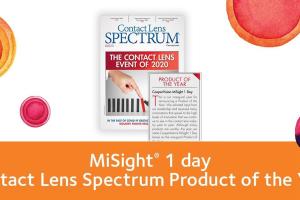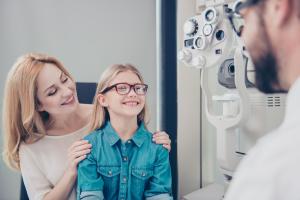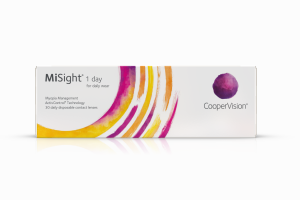
The worldwide increase in myopia prevalence among children is very concerning for eye care providers and public health experts. Current projections expect nearly 5 billion people globally to have myopia by the year 2050, with about 1 billion of these patients with greater than 6 diopters of myopia1. Myopia is much more than the mere inconvenience of needing glasses. Retinal changes associated with myopia, such as maculopathy and retinal detachments, can have significant impacts on vision.2 It is well-established that the risk for these changes escalates with the amount of myopia. The earlier age of myopia onset compounded with the rapid rate of progression justifies the idea that “there is no safe level of myopia”.3
With this at the forefront, an abundance of research has been published looking at the common denominators in myopic children. The conversation returns to the balance between nature and nurture. Though genetic factors play a role, there is increasing evidence that environmental factors may occupy the heavier part of the scale.4 Many experts have analyzed the profiles of children with different visual stimuli and lifestyles, searching for possible harbingers of myopia. Consider a recent finding in the recent epidemiological literature: Children of lower socioeconomic status living in rural Australia had lower rates of myopia than those living in urban areas.5
The environmental factor of rurality is implicated, but what is the underlying relationship to refractive error? When combing through possible contributors within the visual environment, there are some mechanisms worth noting. Light exposure as well as spatial properties in visual stimuli are two of many features that have surfaced with interesting links to myopia.
Light
There appears to be something special about natural light in relation to myopia prevalence: children who spent more time outdoors had a lower incidence of myopia of myopia and later age of onset.6 Though not evaluated in the study with Australian children, outdoor time may have a role in its findings. In addition to numerous studies focused on myopia, the public health literature affirms that children living in rural areas spend more time outdoors than urban counterparts.7 A closer look at the type and duration of outdoor light exposure should be taken to understand its mediating effect on myopia.
A point to explore regarding light exposure is the significant difference between indoor and outdoor light intensity. For reference, common values for the illuminance of a well-lit classroom can be 500 lux, a shaded outdoor area during the day as 5000 lux, and an outdoor field with direct sunlight upwards of 100,000 lux! When enumerated as such, the large discrepancies in light intensities flag itself as a potential predicament. Light stimulates the retina to produce and release dopamine, which is a signal for axial elongation at least in animals.8 In humans, dopamine has not been directly implicated but there is evidence to suggest that axial elongation is associated with less bright light exposure.9 Given the low light intensity in a traditional classroom, strong considerations should be made about how children spend their day at school and outside of school. Time outdoors during school10 and even classroom design change11 can be promising modifications to increase light intensity within the traditional school model.
Children with myopia have been shown to spend less time in bright light conditions as compared to children with emmetropia.12 The specifics of the dose-response curve between light exposure and myopia prevalence is still being investigated, but the inverse relationship has been established. More time spent in moderate intensity light, even if it is not direct sunlight, can be sufficient to benefit both children with and without myopia.13
Spatial Properties
In addition to light, the content of the visual environment seems to have impact on the eye’s development. This is an emerging thought in the understanding of the visual advantages for rural and natural environments over urban and indoor environments. Flitcroft and colleagues recently analyzed urban, indoor, and natural environments and found urban and indoor scenes lack fine details, technically called high spatial frequencies.14 Think how thick of a brush you would need to paint a picture of drab office building walls versus a lush forest with scattered fallen leaves in all directions. The natural environment is rich in details and has relevance to myopia, when modeled in vision research studies using animals. When artificially degraded, stimuli absent of high spatial frequencies can prompt myopic growth in animals.15,16 The low details in man-made environments could presumably have a paralleled effect in the human eye, and could be an unrecognized contributor of myopia.=
In Summary
Numerous previous studies have shown a lower myopia prevalence in children living in rural areas in other parts of the world.17-20 The strength of this association is not in the label of rurality itself but in underlying common denominators. Are there takeaways that can extend beyond the rural population? Surely, there are cases to be made about light and content of visual stimuli, to name a few. The outdoors and natural environment have components that seem to give proper feedback for eye growth. How time is spent at school and on weekends can be reasonable starting points for careful consideration. Parents, educators, and administrators should account for the evidence thus far to thoughtfully optimize children’s visual environments. The great outdoors can be great for children’s eyes, if they make the time.
__________________________________________________________________

Dr. Tiffany Yanase Park graduated magna cum laude from Southern California College of Optometry and completed a pediatric optometry residency at Children’s Hospital Colorado. Dr. Yanase Park now works as part of a university-based pediatric ophthalmology department in Southern California.
References
-
Holden BA et al. Global Prevalence of Myopia and High Myopia and Temporal Trends from 2000 through 2050. Ophthalmology. 2016 May;123(5):1036-42.
-
Haarman AEG, Enthoven CA, Tideman JWL et al. The Complications of Myopia: A Review and Meta-Analysis. Invest Ophthalmol Vis Sci. 2020 Apr;61(4):49.
-
Flitcroft DI. The complex interactions of retinal, optical and environmental factors in myopia aetiology. Prog Retin Eye Res. 2012 Nov;31(6)622-60.
-
Goldschmidt E, Jacobsen N. Genetic and environmental effects on myopia development and progression. Eye (Lond). 2014 Feb;28(2):126-133.
-
Fu A et al. Prevalence of myopia among disadvantaged Australian schoolchildren: a 5-year cross-sectional study. PLoS One. 2020 Aug 27;15(8):e0238122.
-
Xiong S, Sankaridurg P, Naduvilath T, et al. Time spent in outdoor activities in relation to myopia prevention and control: a meta-analysis and systematic review. Acta Ophthalmol. 2017;95(6):551-566.
-
Matz CJ, Stieb DM, Brion O. Urban-rural differences in daily time-activity patterns, occupational activity and housing characteristics. Environ Health. 2015 Nov 13;14:88.
-
Cohen Y et al. Ambient illuminance, retinal dopamine release and refractive development in chicks. Exp Eye Res. 2012;103-33-40.
-
Ulaganathan S et al. Daily axial length and choroidal thickness variations in young adults: Associations with light exposure and longitudinal axial length and choroid changes. Exp Eye Res. 2019 Dec;189:107850.
-
He M et al. Effect of Time Spent Outdoors at School On the Development of Myopia Among Children in China: A Randomized Clinical Trial. JAMA. 2015 Sep 15;314(11):1142-8.
-
Zhou Z et al. Pilot study of a novel classroom designed to prevent myopia by increasing children’s exposure to outdoor light. PLoS One. 2017 Jul 31;12(7):e0181772.
-
Read S et al. Light exposure and physical activity in myopic and emmetropic children. Optom Vis Sci. 2014 Mar;91(3):330-41.
-
Wu PC et al. Myopia Prevention and Outdoor Light Intensity in a School-Based Cluster Randomization Trial. Ophthalmology. 2018 Aug;125(8):1239-1250.
-
Flitcroft DI, Harb EN, Wildsoet CF. The Spatial Frequency Content of Urban and Indoor Environments as a Potential Risk Factors for Myopia Development. Invest Ophthalmol Vis Sci. 2020 Sep; 61(11): 42.
-
Tran N et al. The significance of retinal image contrast and spatial frequency composition for eye growth modulation in young chicks. Vision Res. 2008 Jul;48(15):1655-62.
-
Bowrey HE et al. The relationship between image degradation and myopia in the mammalian eye. Clin Exp Optom. 2015 Nov;98(6):555-63.
-
Guo Y et al. Outdoor activity and myopia among primary students in rural and urban regions of Beijing. Ophthalmology. 2013 Feb;120(2):277-83.
-
Shih YF et al. Comparing myopic progression of urban and rural Taiwanese schoolchildren. Jpn J Ophthalmol. 2010;54(5):446-51.
-
Padhye AS et al. Prevalence of uncorrected refractive error and other eye problems among urban and rural school children. Middle East Afr J Ophthalmol. 2009;16(2):69–74.
-
Gao Z et al. Refractive error in school children in an urban and rural setting in Cambodia. Ophthalmic Epidemiol. 2012;19(1):16–22.








